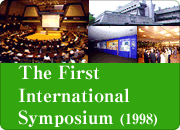Venue : Wakayama Prefectural Culture Hall
Date & Time : From noon of October 25 to 15:00 of October 27 (tentative)
The Exhibition Corners are open to public. No registration for the Symposium is required.
Japan and the other countries are promoting rice research and international technical cooperation amidst the growing cries over food shortages worldwide. The profile of the below two research institutes, JIRCAS and NFRI will be put on display to show what Japan is doing about rice both at home and abroad, and to reconfirm the importance of Japan’s international cooperation with the developing world. Also the profile of IRRI, the international research institute for rice is introduced on display.
| Japan International Research Center for Agricultural Sciences (JIRCAS, Tsukuba, Japan) |
4th Floor Meeting Rm. |
|---|---|
| JIRCAS was established in 1993 through the reorganization of its predecessor, the Tropical Agriculture Research Center (TARC) of the Ministry of Agriculture, Forestry and Fisheries (originally founded in 1970). It was again restructured in 2001 as an Incorporated Administrative Agency for researching agriculture, forestry and fisheries in tropical, subtropical and developing areas. It is contributing to the improvement of agricultural, forestry and fishery technologies in developing countries. | |
| National Food Research Institute (NFRI, Tsukuba, Japan) |
4th Floor Meeting Rm. |
|---|---|
| NFRI was established in 1934 as a Rice Utilization Laboratory. In 1972, it was reorganized under the National Food Research Institute of the Ministry of Agriculture, Forestry and Fisheries and again reorganized as an Incorporated Administrative Agency for researching food in 2001. One of the group of NFRI has developed technologies for identifying rice species and growing regions, as well as for estimating tastes from DNA. | |
| International Rice Research Institute (IRRI, Headquartered in The Philippines) |
4th Floor Meeting Rm. |
|---|---|
| IRRI is a nonprofit international research and training institute specialized in rice. It was established in 1960 with headquarters in The Philippines. IRRI is working to prevent poverty and hunger by promoting cooperation between rice growing nations and consumption nations that leads to stable production and good health amongst growers and consumers. | |
In addition, the following exhibit corners will be set up to show and introduce the history of rice farming and processing into products from past to present.
| Tsukuba Agriculture Research Gallery | Foyer of Main Hall and 3rd Floor Meeting Rm. |
|---|---|
| “The Transformation in Rice Farming Tools” and “New Rice Products” will put on display farming tools, panels, rice, models of tiered rice paddies and more lent from the Ministry of Agriculture, Forestry and Fisheries and the Tsukuba Agriculture Research Gallery. Rice production has supported the Japanese lifestyle by providing food, clothing and shelter. These exhibits will provide visitors an opportunity to think about the culture of rice. | |
| History of Rice Oil | 4th Floor Meeting Rm. |
|---|
| Exhibit of Processed Rice Products and Health Foods using Ingredients derived from Rice Bran | 4th Floor Meeting Rm. |
|---|
| Faith and Foods (Kôyasan, with the Sacred Sites and Pilgrimage Routes in the Kii Mountain Range in Wakayama was registered as UNESCO’s World Heritage in 2004.) |
4th Floor Meeting Rm. |
|---|---|
Kôyasan is home to an active monastic center founded twelve centuries ago by the priest Kûkai for the study and practice of Esoteric Buddhism. It is the headquarters of the Koyasan sect of Shingon Buddhism, a faith with a wide following throughout Japan. |
|
| Open Lecture and Display by Dr. Yoshiko Kagawa, President of Kagawa Nutrition University and by Dr. Toshiyuki Sakai, Professor of Kyoto Prefectural University of Medicine. | 4th and 5th Floor Meeting Rm. |
|---|---|
Dr. Kagawa gives a lecture on her mother who dedicated her life to nutrition science, and Dr. Sakai appeals to young people for mental attitude as a researcher based on his experience of study on cancer prevention. |
|





